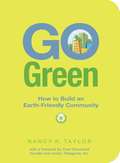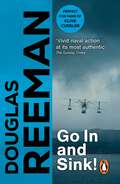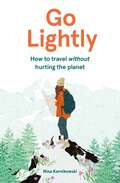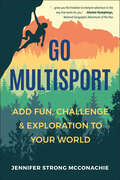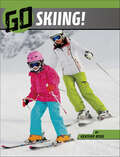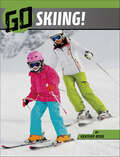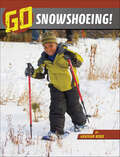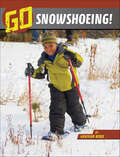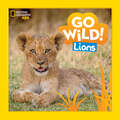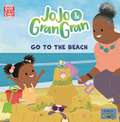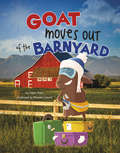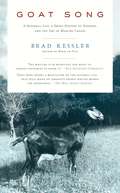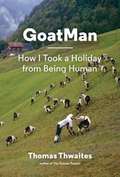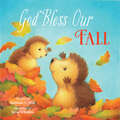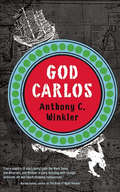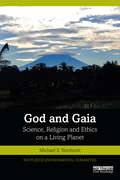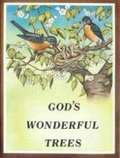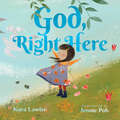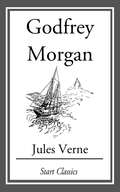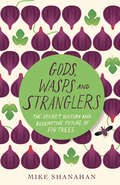- Table View
- List View
Go Green: How to Build an Earth-Friendly Community
by Nancy H. TaylorGo Green is an indispensable resource for the grown-up greenies who have accepted the philosophy and are ready to spread it beyond just their own homes. Go Green offers user-friendly suggestions and case studies for individuals, schools, hospitals, businesses and communities on building or remodeling a green home, starting green programs in the classroom or at hospitals, and finding out what really matters about transportation, food, and renewable energy.
Go In and Sink!: riveting, all-action WW2 naval warfare from Douglas Reeman, the all-time bestselling master of storyteller of the sea
by Douglas ReemanAnother brilliantly immersive, stunning and stirring all-guns-blazing wartime thriller from multi-million copy bestselling author Douglas Reeman. Fans of Clive Cussler, Bernard Cornwell and Wilbur Smith will be gripped from page one! 'One of our foremost writers of naval fiction' -- Sunday Times'Mr Reeman writes with great knowledge about the sea and those who sail on it' --The Times'A gripping read' -- ***** Reader review'This book holds your attention from beginning to end' -- ***** Reader review'A real can't-put-down read' -- ***** Reader review'Another excellent, unputdownable story from the master storyteller, fast paced and full of just the right amount of detail, very believable characters. Get this book!' -- ***** Reader review*******************************************************************************************February 1943: As the balance of the war slowly shifts in Britain's favour, Lieutenant-Commander Steven Marshall brings his battle-scarred submarine into home port. Captain and crew are exhausted after fourteen months' continuous service, but for most there can be no thought of leave. If the enemy collapse in North Africa is to be exploited, every experienced man will be needed. Marshall must return to the Mediterranean, but this time to a very different kind of war. For his new command is secret and extremely hazardous - a captured German U-boat...
Go Lightly: How to travel without hurting the planet
by Nina KarnikowskiThis sustainable travel handbook inspires readers to explore our fascinating planet without causing it further harm. Ten chapters help you go lightly, including how to choose the least impactful methods of travel, how best to protect wildlife, how to pack with more consideration and how to implement mindful practices into each travel day, Go Lightly gives the reader a tool kit of fresh ideas for travelling more consciously. The book also covers eco-friendly activities including biking, boating and camping, and introduces us to some of the world's most inspiring eco-adventure pioneers.
Go Lightly: How to travel without hurting the planet
by Nina KarnikowskiThis sustainable travel handbook inspires readers to explore our fascinating planet without causing it further harm. Ten chapters help you go lightly, including how to choose the least impactful methods of travel, how best to protect wildlife, how to pack with more consideration and how to implement mindful practices into each travel day, Go Lightly gives the reader a tool kit of fresh ideas for travelling more consciously. The book also covers eco-friendly activities including biking, boating and camping, and introduces us to some of the world's most inspiring eco-adventure pioneers.
Go Multisport: Add Fun, Challenge & Exploration to Your World
by Jennifer McConachieThe all-in-one resource and first handbook for multisport athletes with an introduction to the field of multisport and a look at how it came to be and what's next for the sport.Are you ready to Go Multisport? You can run, you can paddle, you can SUP (stand up paddleboard), you can swim, you can ski, you can climb, you can train, and you can bike. But how can you combine them all together? For ultra-like distances and days at a time? How about climbing, hiking, and packrafting all in one day?Beyond traditional 5Ks and 10Ks and single sport extreme and endurance events, is the newly evolving field of multisport. Multisport events are usually self-designed and determined. These extreme athletes most often create their own events because they are the first to do these human-powered endurance challenges.Some examples of multisport athletes include: Nathan Fa&’avae: Winner of the Eco-Challenge World&’s Toughest Race, and 7-time Adventure Racing World Champion Roman Dial: Combines biking and packrafts in the Alaskan backcountry; has made full-length traverses (upward of 700 miles) by foot, ski, pedal and paddle of the Brooks and Alaska Ranges Dave Cornthwaite: Adventurer who created Expedition 1000, a quest to take on 25 journeys, each one a minimum of 1000 miles, using a different way of non-motorized transport throughout the world Alastair Humphreys: A National Geographic Adventurer of the Year for his concept of microadventures, encouraging people to get outside, even in short bouts Perfect for those who are seeking to do more--more challenge, more fun--this book provides a history, background, and empowering how-to. You will learn how to walk the edge of a radical new discipline. Also includes gear lists, sample race challenges, training secrets and more.
Go Paddleboarding! (The Wild Outdoors)
by Heather E. SchwartzEnjoy calm waters and a warm, sunny day on a paddleboard! Readers will learn about the skills and equipment they need to go paddleboarding. Find out important safety rules and ways to protect the environment, all while having fun experiencing this outdoor activity!
Go Paddleboarding! (The Wild Outdoors)
by Heather E. SchwartzEnjoy calm waters and a warm, sunny day on a paddleboard! Readers will learn about the skills and equipment they need to go paddleboarding. Find out important safety rules and ways to protect the environment, all while having fun experiencing this outdoor activity!
Go Skiing! (The Wild Outdoors)
by Heather BodeWhoosh! Feel the rush as you speed down a snowy slope! Get outdoors and enjoy the thrill of skiing. Readers will learn all about the proper clothing, footwear, and supplies they need for both downhill and cross-country skiing. Find out how to stay safe and have fun while taking part in a popular winter sport!
Go Skiing! (The Wild Outdoors)
by Heather BodeWhoosh! Feel the rush as you speed down a snowy slope! Get outdoors and enjoy the thrill of skiing. Readers will learn all about the proper clothing, footwear, and supplies they need for both downhill and cross-country skiing. Find out how to stay safe and have fun while taking part in a popular winter sport!
Go Snowshoeing! (The Wild Outdoors)
by Heather BodeWhat's the best way to enjoy a cold, snowy winter day? Try snowshoeing! Readers will learn all about the proper clothing, footwear, and supplies they need to go snowshoeing in the wild outdoors. They can discover how to have fun while safely exploring the winter world around them.
Go Snowshoeing! (The Wild Outdoors)
by Heather BodeWhat's the best way to enjoy a cold, snowy winter day? Try snowshoeing! Readers will learn all about the proper clothing, footwear, and supplies they need to go snowshoeing in the wild outdoors. They can discover how to have fun while safely exploring the winter world around them.
Go Wild! Lions (Go Wild!)
by Margie MarkarianPlay, pounce, hunt, and ROAR with lions in this lively introduction to these powerful big cats! Learn all about lions, including their awesome body parts, how they hunt, and what life is like in a pride. Little kids will go wild over photos of adorable lion cubs and more as they explore: Where lions live What their families are like How lion babies grow up Other amazing wild cats How lions communicate And moreYoung readers will also find out why lions need our help and what people around the world are doing to protect them. Filled with fun facts, awesome photos, games, and activities that will inspire kids to care about these amazing animals. Complete your collection with: Go Wild! Pandas Go Wild! Sea Turtles Go Wild! Elephants Go Wild! Lemurs
Go to the Beach (JoJo & Gran Gran #2)
by Pat-a-CakeJoJo and Gran Gran are taking a trip to the beach to build a sandcastle. But when JoJo's sandcastle gets trodden on, she feels sad. Can Gran Gran show JoJo that even if their sandcastle doesn't last forever, making memories together is what matters most?About the showJoJo & Gran Gran is the first British-made animated show to feature a black family at its centre. It is based on characters created by Laura Henry Allain, whose own grandmother inspired the character of Gran Gran. Each episode shows a loving relationship a grandmother has with her granddaughter, a celebration of their shared world heritage and wonderful introduction to key preschool first experiences.JoJo adores her grandma, Gran Gran, and they love to spend time together while JoJo's Mummy and Daddy are at work. Gran Gran always has something exciting planned when JoJo comes to visit.Each picture book will retell the story of a well-loved TV episode, followed by a picture glossary and activity spread to encourage readers to take the themes from the book into their everyday.
Go, Go, Go!: Kids on the Move (Fountas & Pinnell LLI Blue #Level H)
by Stephen SwinburneA child's world is full of movement. Whether at play or out of sheer joy, you are constantly on the go. This lively book shows kids doing what they enjoy--jumping and dancing, and cartwheeling and bouncing through their days. Stephen Swinburne celebrates kids and their boundless energy in a bright, playful photo essay that shows you some of the amazing ways a child's body can move and invites young ones to discover fresh ways to dance and twirl through the world.
Goat Moves Out of the Barnyard (Habitat Hunter)
by Nikki PottsGoat is bored with its habitat! Follow Goat as it tries out different places to live. Which habitat will make the best home for Goat?
Goat Song: A Seasonal Life, A Short History of Herding, and the Art of Making Cheese
by Brad KesslerAcclaimed novelist Brad Kessler lived in New York City but longed for a life on the land where he could grow his own food. After years of searching for a home, he and his wife, photographer Dona Ann McAdams, found a mountain farmhouse on a dead-end road, with seventy-five acres of land. One day, when Dona returned home with fresh goat milk from a neighbor's farm, Kessler made a fresh chèvre, and their life changed forever. They decided to raise dairy goats and make cheese. Goat Song tells about what it's like to live intimately with animals who directly feed you. As Kessler begins to live the life of a herder -- learning how to care for and breed and birth goats -- he encounters the pastoral roots of so many aspects of Western culture. Kessler reflects on the history and literature of herding, and how our diet, our alphabet, our religions, poetry, and economy all grew out of a pastoralist milieu among hoofed animals. Kessler and his wife adapt to a life governed by their goats and the rhythm of the seasons. And their goats give back in immeasurable ways, as Kessler proves to be a remarkable cheesemaker, with his first tomme of goat cheese winning lavish praise from America's premier cheese restaurants. In the tradition of Thoreau's Walden and Annie Dillard's Pilgrim at Tinker Creek, Goat Song is both a spiritual quest and a compelling and beautiful chronicle of living by nature's rules.
GoatMan: How I Took a Holiday from Being Human
by Thomas ThwaitesThe dazzling success of The Toaster Project, including TV appearances and an international book tour, leaves Thomas Thwaites in a slump. His friends increasingly behave like adults, while Thwaites still lives at home, "stuck in a big, dark hole." Luckily, a research grant offers the perfect out: a chance to take a holiday from the complications of being human--by transforming himself into a goat. What ensues is a hilarious and surreal journey through engineering, design, and psychology, as Thwaites interviews neuroscientists, animal behaviorists, prosthetists, goat sanctuary workers, and goatherds.From this, he builds a goat exoskeleton--artificial legs, helmet, chest protector, raincoat from his mum, and a prosthetic goat stomach to digest grass (with help from a pressure cooker and campfire)--before setting off across the Alps on four legs with a herd of his fellow creatures. Will he make it? Do Thwaites and his readers discover what it truly means to be human?GoatMan tells all in Thwaites's inimitable style, which NPR extols as "a laugh-out- loud-funny but thoughtful guide through his own adventures."
God Bless Our Fall (A God Bless Book)
by Hannah HallShare the blessings of fall with your little one in God Bless Our Fall. Children will enjoy the bright autumn colors and cozy rhymes in this sweet board book that celebrates the harvest season with woodland animals.Parents and children will cuddle up together again and again to see the snuggly animal families enjoy their fall activities and hear the sweet rhyming story. Pumpkin patches, apple harvests, leaves that change color, hayrides, warm beverages, cozy clothes—God Bless Our Fall highlights all the wonderful things families get to enjoy together when the air turns crisp and cool. This board book is a wonderful way to introduce fun fall traditions to little ones and guide them in giving thanks for God&’s blessings of the season. God Bless Our Fall, for children ages 0–4, featuresbeautiful rhyming verses that give thanks for God&’s creation;bright, colorful illustrations that show foxes, squirrels, deer, and other woodland animals; anda padded cover, perfect for little hands and cozying up together for a read-aloud story time.Featuring the same talented writer and illustrator combination from God Bless You and Good Night, God Bless Our Fall makes a great gift forgrandparents and parents with little ones who enjoy fall; andseasonal holiday gift giving, such as harvest celebrations, Thanksgiving, or autumn festivals.Check out these other books in the A God Bless Book series:God Bless You and Good NightGod Bless You and Good Night Touch and FeelGod Bless Our EasterGod Bless Our ChristmasGod Bless My Boo BooGod Bless Our BabyGod Bless Our CountryGod Bless My FriendsGod Bless My FamilyGod Bless My SchoolGod Bless Our Bedtime Prayers
God Carlos
by Anthony C. WinklerA finalist for the 2014 Townsend Prize for Fiction!God Carlos has been long-listed for the OMC Bocas Prize for Caribbean Literature in Trinidad."A gusty, boisterous, and entertaining slice of historical fiction. In scenes of a mixture of pride, madness, and comedy, Carlos plays out his role as deity among the naked islanders, living a fantasy that most readers will find believable, if horrific. Along with the horror, the book does offer some beautiful moments of discovery, as when, as Winkler narrates, the ship takes the Mona Passage to Jamaica . . . we hear of an Edenic island, green and aromatic, opened like a wildflower. For all of its scenes of braggadocio and brutality, the book often works on you like that vision."--Alan Cheuse, NPR, All Things Considered"Readers are transported to Jamaica, into Winkler's richly invented 16th century, where his flawless prose paints their slice of time, in turn both brutally graphic and lyrically gorgeous. Comic, tragic, bawdy, sad, and provocative, this is a thoroughly engaging adventure story from a renowned Jamaican author, sure to enchant readers who treasure a fabulous tale exquisitely rendered."--Library Journal"A tale of the frequently tragic--and also comic--clash of races and religions brought on by colonization...Anthony Winkler spins an enlightened parable, rich in historical detail and irony."--Shelf Awareness"Darkly irreverent . . . With a sharp tongue, Winkler, a native of Jamaica, deftly imbues this blackly funny satire with an exposé of colonialism's avarice and futility."--Publishers Weekly"With perceptive storytelling and bracing honesty, Mr. Winkler, author of a half-dozen well-reviewed books, has a lovely way of telling a good story and educating concurrently . . . God Carlos teaches history in a subtle but meaningful way. Too literary to be lumped in with typical historical fiction, and too historical to be lumped in with typical literary fiction, God Carlos defies categorization."--New York Journal of BooksGod Carlos transports us to a voyage aboard the Santa Inez, a Spanish sailing vessel bound for the newly discovered West Indies with a fortune-seeking band of ragtag sailors. She is an unusual explorer for her day, carrying no provisions for the settlers, no seed for planting crops, manned by vain, arrogant men looking for gold in Jamaica.Expecting to make landfall in paradise after over a month at sea, the crew of the Santa Inez instead find themselves in the middle of a timid, innocent people--the Arawaks--who walk around stark naked without embarrassment and who venerate their own customs and worship their own Gods and creeds. The European newcomers do not find gold, only the merciless climate that nourishes diseases that slaughter them. That the Arawaks believed that the arrivals were from heaven makes even more complicated this impossible entanglement of culture, custom, and beliefs, ultimately leading to mutual doom.
God and Gaia: Science, Religion and Ethics on a Living Planet (Routledge Environmental Humanities)
by Michael S NorthcottGod and Gaia explores the overlap between traditional religious cosmologies and the scientific Gaia theory of James Lovelock. It argues that a Gaian approach to the ecological crisis involves rebalancing human and more-than-human influences on Earth by reviving the ecological agency of local and indigenous human communities, and of nonhuman beings. Present-day human ecological influences on Earth have been growing at pace since the Scientific and Industrial Revolutions, when modern humans adopted a machine cosmology in which humans are the sole intelligent agency. The resultant imbalance between human and Earthly agencies is degrading the species diversity of ecosystems, causing local climate changes, and threatens to destabilise the Earth as a System. Across eight chapters this ambitious text engages with traditional cosmologies from the Indian Vedas and classical Greece to Medieval Christianity, with case material from Southeast Asia, Southern Africa and Great Britain. It discusses concepts such as deep time and ancestral time, the ethics of genetic engineering of foods and viruses, and holistic ecological management. Northcott argues that an ontological turn that honours the differential agency of indigenous humans and other kind, and that draws on sacred traditions, will make it is possible to repair the destabilising impacts of contemporary human activities on the Earth System and its constituent ecosystems. This book will be of considerable interest to students and scholars of the environmental humanities, history, and cultural and religious studies.
God's Wonderful Trees
by Mary M. Landis"God’s trees are a wonderful gift. They make the earth beautiful. What can a tree Do for me?"
God, Right Here: Meeting God in the Changing Seasons
by Kara LawlerGod, right here. God, right there. God's handiwork is everywhere. Yellow daffodils, flying seagulls, bright orange pumpkins, and swirling snowflakes—God's handiwork can be found all throughout nature, and every season is full of beauty and wonder. Everywhere we look, no matter the time of year, the wonders of creation remind us that God is always with us, always right here. Written by Kara Lawler and beautifully illustrated by Jennie Poh, this celebration of God's creation and the changing seasons can be enjoyed by children and the adults who read with them. Also included is a note from the author to encourage further conversation about the content. Discover IVP Kids and share with children the things that matter to God!
Godfrey Morgan
by Jules Verne"Godfrey Morgan: A Californian Mystery", also published as "School for Crusoes", is an 1882 adventure novel by French writer Jules Verne. It tells of a young adventurer, Godfrey Morgan, and his deportment instructor, Professor T. Artelett, who embark on a round-the-world ocean voyage. Their ship is wrecked and they are cast away on a remote island, where they rescue and befriend an African slave, Carefinotu.
Gods of the Morning: A Bird's-Eye View of a Changing World
by John Lister-KayeA celebration of birds that reflects a year in the wild, revealing how these amazing creatures embody our changing world, by one of Britain's foremost naturalists. Gods of the Morning follows the year through the turning of the seasons at Aigas, the Highlands estate John Lister-Kaye has transformed into a world-renowned wildlife center. John's affection, wisdom and lyricism sings off every page, bringing the natural world around him to life: from the rookery filled with twenty-nine nests and distinct bird calls to descriptions of the winter morning light, from the wood mice and the squirrels preparing for winter to tracking a fox's path through the snow. In particular it brings John's lifelong love of birds--his gods of the morning--to the fore. In the Highland glens, bird numbers plummet as their food supplies--natural fruits and every kind of creeping, crawling, slithering or flying bug--begin to disappear. Not just the swallows and house martins have vanished from round the houses. Gone are the insect snatching wheatears, whinchats and stonechats from the hills, and redstarts and flycatchers have fled the woods. Pied wagtails no longer flicker across the lawns and sandpipers and grey wagtails have deserted the river banks. Farmland and hedgerow species have vanished in the night: the linnets, yellowhammers, and all the warblers have decamped from the thickets. By the first frosts the hills will have emptied down to a few hardy stalwarts such as the golden eagles, the raven and the irrepressible hooded crows. Silence settles across the land. The few species that are left frequent a changed world. Soon only the buzzards and wood pigeons will hang on in the woods and the coniferous forests will be host to flocks of chaffinches, tits, siskins, and crossbills passing through.
Gods, Wasps and Stranglers: The Secret History and Redemptive Future of Fig Trees
by Mike Shanahan&“If you&’re looking for a dose of wonder in your reading life, I recommend this beautiful book about the magic of fig trees.&”—Book RiotOver millions of years, fig trees have shaped our world, influenced our evolution, nourished our bodies and fed our imaginations. And as author and ecologist Mike Shanahan proclaims, &“The best could be yet to come.&”Gods, Wasps and Stranglers weaves together the mythology, history and ecology of one of the world&’s most fascinating—and diverse—groups of plants, from their starring role in every major religion to their potential to restore rainforests, halt the loss of rare and endangered species and even limit climate change.In this lively and joyous book, Shanahan recounts the epic journeys of tiny fig wasps, whose eighty-million-year-old relationship with fig trees has helped them sustain more species of birds and mammals than any other trees; the curious habits of fig-dependent rhinoceros hornbills; figs&’ connection to Krishna and Buddha, Jesus and Muhammad; and even their importance to Kenya&’s struggle for independence.Ultimately, Gods, Wasps and Stranglers is a story about humanity&’s relationship with nature, one that is as relevant to our future as it is to our past.&“Surprising, engrossing, disturbing and promising, Gods, Wasps and Stranglers combines masterful storytelling and spellbinding science. This is a beautifully written and important book about trees that have shaped human destiny.&”—Sy Montgomery, author of The Soul of an Octopus
